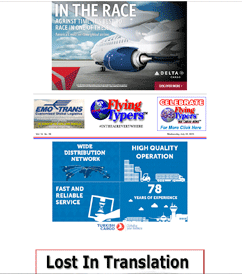| 
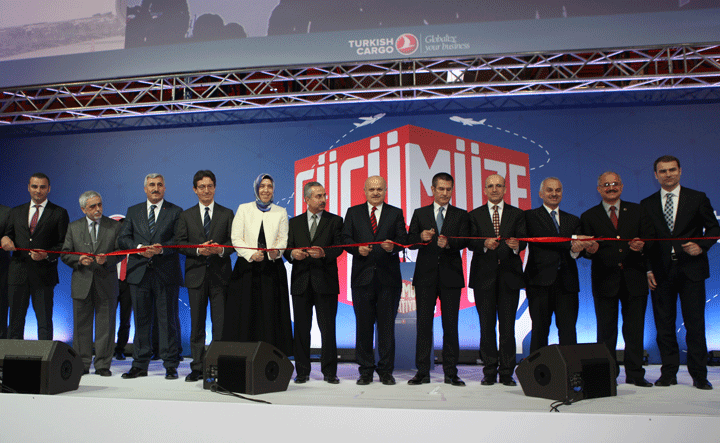
 (Dateline
Istanbul)—Our first impression upon walking into the building was
that we had just landed at Google Headquarters. (Dateline
Istanbul)—Our first impression upon walking into the building was
that we had just landed at Google Headquarters.
The space was so big, bright, and airy,
and filled with young, smart looking, purpose-driven people.
In this business, the opening of air cargo
handling terminals occurs on a regular schedule, and each is undoubtedly
filled with the hopes and dreams of everyone involved in its creation.
Over the years we have had the pleasure
and honor of seeing some imaginative facilities debut, both at home in
the U.S. and around the world in places like Singapore, the UK, and Dubai.
But a few weeks ago we travelled to Istanbul
to see the new Cargo Transfer Facility (CTF) that Turkish Airways Cargo
opened January 1, 2015.
The new Turkish Cargo CTF is not only big,
broad-shouldered, beautiful and situated on a tract of land at Ataturk
International Airport that will allow for certain expansion in the future,
it is a place of expanded capabilities and great promise. It touches every
aspect of the transportation art, punctuated by a light and airy openness
that lends itself to the business of air cargo and lifts the spirit and
imagination of everybody that comes into contact.
Turkish CTF Istanbul is the right place
at the right time, and even for an old cargo hand it’s nothing short
of amazing.
No, it is not about bells and whistles or
razzle-dazzle; what is going on here is smart cargo operations at the
hub level, with the potential and benefits to rise up and meet any challenge
both today and during the upcoming seasons.
Put simply, Turkish Cargo has now moved
further center stage to claim its rightful leadership position on the
world cargo air lanes.
Systems &
People
Rather than rush to judgment by slapping
a building full of systems and then hoping everything will work all at
once (a mistake that has been made time and again by others), Turkish
planners and builders opted to take a patient, measured approach, fully
fitting out the new CTF whilst measuring some long term decisions about
next generation systems.
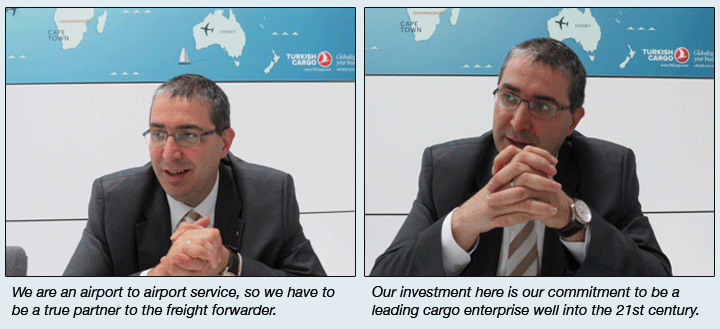
But what just knocks us out about the Turkish
Cargo IST CTF is how the building deals with the people who work there:
the human dimension. It’s the engine that drives everything.
CTF is a space that allows for everybody
inside to view operations and vital activity, offering an unobstructed
view of the cargo workspace through giant floor-to-ceiling window walls.
The view imparts a sense of motion and interaction,
a ballet that can only help encourage ideas, sharing, cooperation, and
other efficiencies.
Inside, the Turkish Airlines Istanbul Cargo
Transfer Facility staff meeting rooms—where the strategies are planned—are
situated facing the air cargo action.
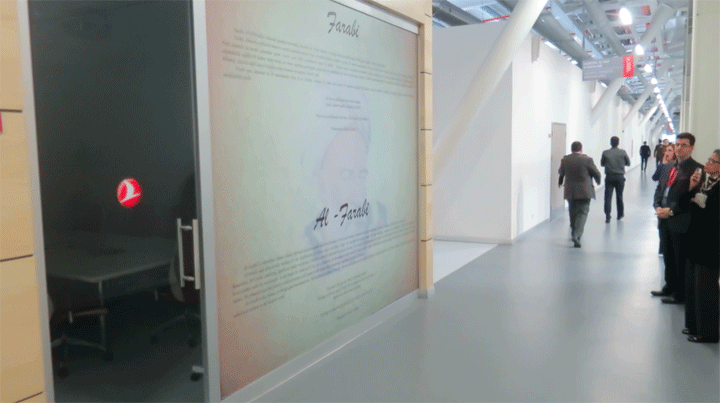
There is also a sense of history as interior
wall spaces tell the story of great Arab philosophers, poets, scientists
and mathematicians, including Abu Nasar Al Farabi and Jallaludin Rumi,
whose messages spread to impact people all over the world.
A bright, busy cafeteria that seats 600
people faces the pallet build up area so that meals (there are no special
classes here, meaning both white and blue collar employees dine in the
same space) at CTF include an overview of the build up process.
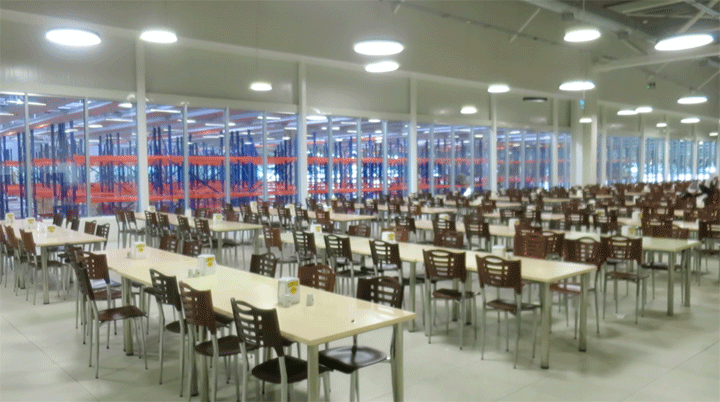
Looking a bit further into the Turkish CTF,
we also noted only three private offices in the entire place.
The main gallery where all the people sit
on the top floor includes 300 meters of open plan offices under high ceilings
with exposed heating and cooling. Everything is painted white, elevating
the open Bauhaus feel of the place in an upward sweep of understated functional
elegance.
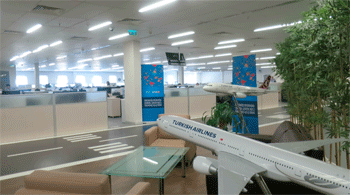 |
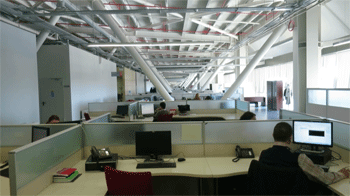 |
“I get a very good daily workout walking
back and forth here, before I go to work each day, and also sometimes
to work off lunch,” smiles Turkish Cargo Vice President Sales Halit
Anlatan.
“Our new cargo facility offers streamlined
operational processes that have been redesigned, and service quality has
been maximized.
“Our network of more than 260 destinations
in 108 countries, currently served by 9 freighters with 48 destinations
and 253 passenger airplanes, has a center port for a growing business
in air cargo.
“The CTF includes a larger cargo acceptance
area, accelerating cargo processes.
“We have also optimized space for
specialty cargo with dedicated areas to handle every consignment from
bulk to refrigerated to high value to express—you name it.
“Whether Live Animals (AVI), Dangerous
Goods (DG), Vulnerable Cargo (VUN), Valuable Cargo (VAL), or anything
else.
“If it can be shipped by air, our
CTF has a place for the cargo via Istanbul,” Halit insists.
The cargo admission and delivery space includes
53 bays, with several gates dedicated to TK Plus and special cargo.
Also vehicle admission areas are 42 m. wide,
allowing vehicle traffic and maneuvering to be managed smoothly.
Accommodation of many different types of
vehicles will be facilitated by means of movable level adjusters.
Room To Grow
Technical Specifications of the New Cargo
Facility put future annual throughput tonnage capacity at 1.2 million
tons, but Halit points out there is room to grow.
First He
Helped Build It
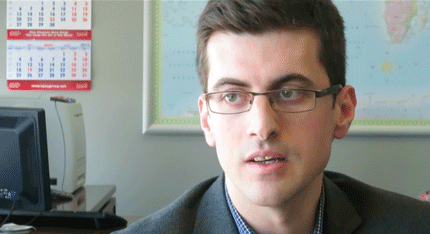 Mustafa
Kemal Ozahi is project engineer for Turkish Cargo. Mustafa
Kemal Ozahi is project engineer for Turkish Cargo.
As part of the team that planned and built
CTF, today Mustafa Kemal helps operate while keeping a weathered eye out
for the facility.
Mustafa Kemal studied industrial engineering
in school but then worked in logistics for the fashion industry.
Having spent time on the customer side of
the equation he notes a keen awareness of their needs, which gives him
knowledge that has served him well both in the design stage and today
in the ongoing implementation of operations for the new Istanbul hub.
“Actually, when we launched CTF on
January 1, we moved operations into the new facility and had everything
done in one day with no problems,” said Mustafa Kemal.
“We were keenly aware that our former
facility here was a level two facility. “Too much wasted motion.
“Our biggest challenge in this new
CTF was changing the mindset.
“People, we felt, would revert to
the processes they were familiar and comfortable with from habit.
“So we commenced staff retraining
prior to the move last August 1.
“Today, everyone is on the same page.
“There is total seamlessness and transparency
in communication here because of the physical layout of the building.
“That is a real plus for the three
shifts a day with 200 people, four shift managers, and eight shift supervisors.
“Our old facility could handle 550,000
tons, today we are handling 700,000 tons.
“The projection ahead 4 years is 1.2
million tons annually.
“Looking ahead we are changing our
IT set up to IBS.
“We currently have sent staff to Lufthansa,
our alliance partner, to learn best practices, among other things,”
Mustafa Kemal said.
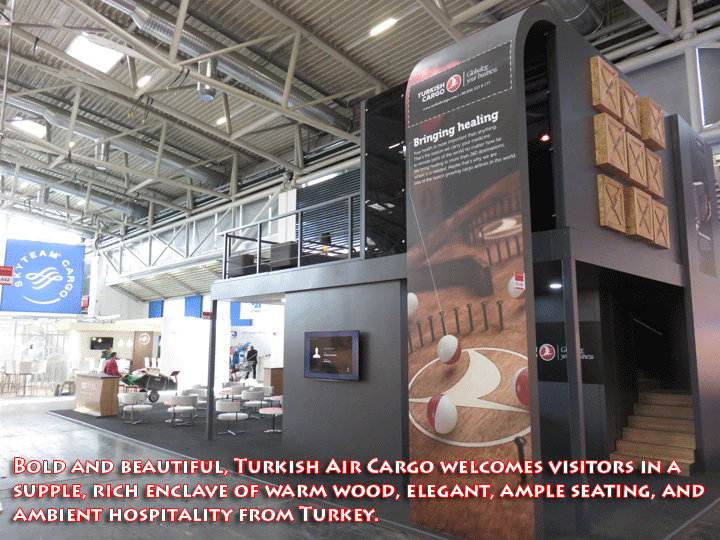
The Vision
Thing
“Bringing this great facility forward
we notice that there is better and clearer focus on vision—that
allows better interaction for everyone working together as a team, to
share the same passion,” said Mr. Anlatan.
“We are an airport to airport service,
so we have to be a true partner to the freight forwarder.
“Right now, price has become a bargaining
chip because of the cost of fuel, but we buy in Kazakhstan where nothing
has changed.
“So the bottom line is Turkish customer
service.
“We are not an industrial country;
we are a trading conduit.
“Now, in addition to our growing,
modern air fleet (including freighters), our incredible geographic location
as a nation and gateway, and the determined effort of a truly dedicated
air cargo management and staff, we move ahead in 2015 seeking new business
and challenges.
“This facility is the new landmark
for air shippers.
“Our investment here is our commitment
to a long-term program to take our cargo enterprise in a leading direction
well into the 21st century.
“Turkish Cargo can handle it,”
Halit Anlatan said.
Geoffrey/Sabiha
|














 (Dateline
Istanbul)—Our first impression upon walking into the building was
that we had just landed at Google Headquarters.
(Dateline
Istanbul)—Our first impression upon walking into the building was
that we had just landed at Google Headquarters.




 Mustafa
Kemal Ozahi is project engineer for Turkish Cargo.
Mustafa
Kemal Ozahi is project engineer for Turkish Cargo.


